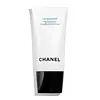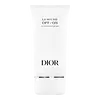What's inside
What's inside
 Key Ingredients
Key Ingredients

 Benefits
Benefits

 Concerns
Concerns

 Ingredients Side-by-side
Ingredients Side-by-side

Water
Skin ConditioningGlycerin
HumectantSodium Palmitate
CleansingSodium Stearate
CleansingSodium Methyl Cocoyl Taurate
CleansingPolyethylene
AbrasivePotassium Palmitate
EmulsifyingPotassium Stearate
CleansingSodium Laurate
CleansingPotassium Laurate
EmulsifyingPalmitic Acid
EmollientStearic Acid
CleansingPotassium Myristate
EmulsifyingLauric Acid
CleansingSodium Myristate
CleansingPEG-3 Distearate
EmulsifyingSalicornia Herbacea Extract
Skin ConditioningAlgae Extract
EmollientSodium Laureth Sulfate
CleansingCaprylic/Capric Triglyceride
MaskingMyristic Acid
CleansingParfum
MaskingSodium Cocoyl Isethionate
CleansingWater, Glycerin, Sodium Palmitate, Sodium Stearate, Sodium Methyl Cocoyl Taurate, Polyethylene, Potassium Palmitate, Potassium Stearate, Sodium Laurate, Potassium Laurate, Palmitic Acid, Stearic Acid, Potassium Myristate, Lauric Acid, Sodium Myristate, PEG-3 Distearate, Salicornia Herbacea Extract, Algae Extract, Sodium Laureth Sulfate, Caprylic/Capric Triglyceride, Myristic Acid, Parfum, Sodium Cocoyl Isethionate
Water
Skin ConditioningGlycerin
HumectantLauric Acid
CleansingStearic Acid
CleansingSodium Methyl Cocoyl Taurate
CleansingMaltooligosyl Glucoside
Skin ConditioningPalmitic Acid
EmollientSodium Hydroxide
BufferingHydrogenated Starch Hydrolysate
HumectantParfum
MaskingGlyceryl Stearate
EmollientPEG-100 Stearate
Pentaerythrityl Tetrabehenate
EmollientNymphaea Alba Root Extract
Skin ConditioningDipotassium Glycyrrhizate
HumectantCoco-Betaine
CleansingPotassium Hydroxide
BufferingChlorphenesin
AntimicrobialSodium Cocoyl Isethionate
CleansingSodium Benzoate
MaskingPotassium Sorbate
PreservativeTocopherol
AntioxidantCitric Acid
BufferingCaprylyl Glycol
EmollientPolyquaternium-22
Water, Glycerin, Lauric Acid, Stearic Acid, Sodium Methyl Cocoyl Taurate, Maltooligosyl Glucoside, Palmitic Acid, Sodium Hydroxide, Hydrogenated Starch Hydrolysate, Parfum, Glyceryl Stearate, PEG-100 Stearate, Pentaerythrityl Tetrabehenate, Nymphaea Alba Root Extract, Dipotassium Glycyrrhizate, Coco-Betaine, Potassium Hydroxide, Chlorphenesin, Sodium Cocoyl Isethionate, Sodium Benzoate, Potassium Sorbate, Tocopherol, Citric Acid, Caprylyl Glycol, Polyquaternium-22
 Reviews
Reviews

Ingredients Explained
These ingredients are found in both products.
Ingredients higher up in an ingredient list are typically present in a larger amount.
Glycerin is already naturally found in your skin. It helps moisturize and protect your skin.
A study from 2016 found glycerin to be more effective as a humectant than AHAs and hyaluronic acid.
As a humectant, it helps the skin stay hydrated by pulling moisture to your skin. The low molecular weight of glycerin allows it to pull moisture into the deeper layers of your skin.
Hydrated skin improves your skin barrier; Your skin barrier helps protect against irritants and bacteria.
Glycerin has also been found to have antimicrobial and antiviral properties. Due to these properties, glycerin is often used in wound and burn treatments.
In cosmetics, glycerin is usually derived from plants such as soybean or palm. However, it can also be sourced from animals, such as tallow or animal fat.
This ingredient is organic, colorless, odorless, and non-toxic.
Glycerin is the name for this ingredient in American English. British English uses Glycerol/Glycerine.
Learn more about GlycerinLauric Acid is a fatty acid or lipid. About half of fatty acids in coconut oil is lauric acid.
This ingredient helps hydrate and sooth skin. As a humectant, it helps trap moisture. It also aids in cleaning and enhancing the texture of products.
Lauric acid may not be Malassezia folliculitis, or fungal acne, safe.
Learn more about Lauric AcidPalmitic Acid is a fatty acid naturally found in our skin and in many plant and animal sources. In cosmetics, it is usually derived from palm oil. It serves many purposes in skincare, acting as a cleanser, emollient, and emulsifier.
As an emollient, palmitic acid helps soften and smooth the skin by preventing water loss. In cleansers, it helps remove oil and dirt while creating foam.
Its emulsifying properties help stabilize products by keeping water and oil-based ingredients from separating.
This may not be suitable for fungal acne-prone skin, as fatty acids like this can sometimes trigger breakouts in sensitive individuals.
Learn more about Palmitic AcidParfum is a catch-all term for an ingredient or more that is used to give a scent to products.
Also called "fragrance", this ingredient can be a blend of hundreds of chemicals or plant oils. This means every product with "fragrance" or "parfum" in the ingredients list is a different mixture.
For instance, Habanolide is a proprietary trade name for a specific aroma chemical. When used as a fragrance ingredient in cosmetics, most aroma chemicals fall under the broad labeling category of “FRAGRANCE” or “PARFUM” according to EU and US regulations.
The term 'parfum' or 'fragrance' is not regulated in many countries. In many cases, it is up to the brand to define this term.
For instance, many brands choose to label themselves as "fragrance-free" because they are not using synthetic fragrances. However, their products may still contain ingredients such as essential oils that are considered a fragrance by INCI standards.
One example is Calendula flower extract. Calendula is an essential oil that still imparts a scent or 'fragrance'.
Depending on the blend, the ingredients in the mixture can cause allergies and sensitivities on the skin. Some ingredients that are known EU allergens include linalool and citronellol.
Parfum can also be used to mask or cover an unpleasant scent.
The bottom line is: not all fragrances/parfum/ingredients are created equally. If you are worried about fragrances, we recommend taking a closer look at an ingredient. And of course, we always recommend speaking with a professional.
Learn more about ParfumSodium cocoyl isethionate is a natural ingredient from coconut oil. It is an ultra gentle cleanser that gives a nice foam without drying the skin or impacting the skin barrier.
The amount of foam created depends on the amount of sodium cocoyl isethionate used in the product.
This ingredient also helps improve the spreadability of a product.
Learn more about Sodium Cocoyl IsethionateThis gentle cleansing and foaming ingredient is known for leaving a smooth feeling in skin and hair. It is made using coconut oil.
According to the manufacturer, it is soluble in water and has resistance to hard water, acid, and alkali.
Due to its coconut base, it may not be Malassezia folliculitis safe.
Learn more about Sodium Methyl Cocoyl TaurateStearic Acid is a fatty acid. It is an emollient, emulsifier, and texture enhancer.
As an emollient, stearic acid helps soften skin. It aids the skin's protective barrier by preventing water loss. It also provides a gentle cleansing effect without stripping away natural oils.
Stearic acid may also be used to enhance the texture of products. It can add volume and stabilize ingredients such as water and oil. This can help water and oil ingredients from separating.
Sources of stearic acid include animal or vegetable fats/oils such as coconut or shea. It can be naturally found in butter, cocoa butter, shea butter, vegetable fats, and animal tallow.
This ingredient may not be Malassezia folliculitis, or fungal-acne safe.
Learn more about Stearic AcidWater. It's the most common cosmetic ingredient of all. You'll usually see it at the top of ingredient lists, meaning that it makes up the largest part of the product.
So why is it so popular? Water most often acts as a solvent - this means that it helps dissolve other ingredients into the formulation.
You'll also recognize water as that liquid we all need to stay alive. If you see this, drink a glass of water. Stay hydrated!
Learn more about Water